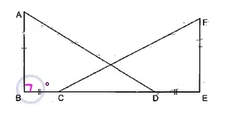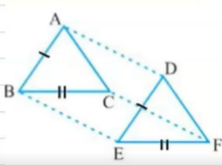Two organic compounds (A) and (B) with molecular formula, C3H6O , react with HCN in different manner to produce (C) and (D) respectively. One subsequent hydrolysis of (C) and (D) give optically active substances (E) and (F). Both (E) and (F) on decarboxylation give I - propanol . What are (A), (B) , (C) , (D) , (E) and (F) ? Solution in Telugu
(A) is CH3CH2CHO, (B) is CH2=CHCH2OH, (C) is CH3CH2CH(OH)CN, (D) is CH3−CH(CN)CH2OH, (E) is CH3CH2CH(OH)COOH and (F) is CH3CH(COOH)CH2OH. (E) and (F) are optically active.
Topper's Solved these Questions
- BOOK - AAKASH SERIESCHAPTER - ALDEHYDES AND KETONESEXERCISE - Subjective exercise - 1 (Short answer Questions)6videos
ALDEHYDES AND KETONES
- BOOK - AAKASH SERIESCHAPTER - ALDEHYDES AND KETONESEXERCISE - Subjective exercise - 1 (Very short answer questions)3videos
ALDEHYDES AND KETONES
- BOOK - AAKASH SERIESCHAPTER - ALDEHYDES AND KETONESEXERCISE - PRACTICE SHEET-334videos
ALDEHYDES AND KETONES
- BOOK - AAKASH SERIESCHAPTER - ALCOHOLS, PHENOLS AND ETHERSEXERCISE - ETHERS (OBJECTIVE EXERCISE-4)50videos
ALCOHOLS, PHENOLS AND ETHERS
- BOOK - AAKASH SERIESCHAPTER - ALKYL AND ARYL HALIDESEXERCISE - OBJECTIVE EXERCISE - 4 (ASSERTION (A) & REASON (R) TYPE QUESTIONS)19videos
ALKYL AND ARYL HALIDES
Similar Questions
What are aldehydes and ketones ? Give the structural differences .
02:38View SolutionWrite the IUPAC names for the following
Cl∣CH2−CHO,Cl∣CH2−O∣∣C−CH302:10View SolutionWhich of the following is likely to highest melting point
03:25View Solution(A): Alcoholic fermentation involves conversion of sugar into ethanol by the action of yeast.
(R): Fermentation involves the liberation of CO2 gas.02:07View Solution(A) Towards SN2 reaction, order of reactivity is CH3Br>CH3CH2Br>(CH3)2CHBr>(CH3)3CBr.
(R) Greater the stability of carbocation, greater will be its ease of formation from alkyl halide and faster will be the rate of SN1 reaction.05:38View SolutionIf ABC and DEF are two triangles such that ABDE=BCEF=CAFD=25 , then Area(ABC):Area(DEF)= 2:5 (b) 4:25 (c) 4:15 (d) 8:125
08:08View SolutionIf in two triangles ABC and DEF , ABDE=BCFE=CAFD , then FDECAB (b) FDEABC (c) CBAFDE (d) BCAFDE
03:29View SolutionD, E, F are the mid-point of the sides BC, CA and AB respectively of ABC. Then DEF is congruent to triangle. ABC (b) AEF (c) BFD, CDE (d) AFE, BFD, CDE
Given : D, E, F are the mid-point of the sides BC, CA and AB .
View SolutionIn Figure, AB⊥BEandFE⊥BE.If BC=DEandAB=EF, then ABD is congruent to:
(a)EFC
(b) ECF
(c) CEF
(d) FEC
 01:53View Solution
01:53View SolutionIf ABC and DEF are two triangles such that AB, BC are respectively equal and parallel to DE, EF, then show that Quadrilateral ABED is a parallelogram Quadrilateral BCFE is a parallelogram AC=DF (iv) ABC ≅ DEF
 View Solution
View SolutionTwo organic compounds (A) and (B) containing 62.01% C and 10.3% H react with HCN in different manners to produce (C ) and (D), respectively. Subsequent hydrolysis of (C ) and (D) gives optically active compounds (E ) and (F). Both (E ) and (F) on decarboxylation give the same compound (G). Identify the compounds (A) to (G).
View SolutionThe three compounds (A),(B), and (C) on hydrogenation with H_(2)+Pd give (D),(E) and (F) , respectively. Compounds (D),(E) and (F) are :
04:27View SolutionTwo organic compounds (A) and (B) with molecular formula, C_(3)H_(6)O , react with HCN in different manner to produce (C) and (D) respectively. On subsequent hydrolysis of (C) and (D) gives optically active substances (E) and (F). Both (E) and (F) on decarboxylation give propan -1-ol. What are (A),(B) (C),(E)and (F)?
03:59View Solutiona d c e b e d f e h e ?
02:19View SolutionAn organic compound (A) of molecular formula C6H6reacts with propylene in the presence of H3PO4 at 532 K gives (B) formula C9H12. (B) on air oxidation gives C9H12O2as (C ).(C ) on acidification with H2SO4 gives (D) of formula C6H6O and (E) of formula C3H6O. Identify A,B,C,D and E and explain the reaction.
04:50View SolutionAn alkene (A) on ozonolysis gives propanone and aldehyde (B). When (B) is oxidised (C) is obtained. (C) is treated with Bry/P gives (D) which on hydrolysis gives (E). When propanone is treated with HCN followed by hydrolysis gives (F). Identify A, B, C, D and E and F.
02:06View Solution

